Sim-plicity: I am a bridge builder

Having retired from world-saving heroics, Christopher Livingston is living the simple life in video games by playing a series of down-to-earth simulations. This week he takes a job as a bridge planner, but will he wind up building bridges or just burning them?
Bridge Project has maps, and those maps have gaps, and those gaps need something that unfortunately doesn't rhyme with maps or gaps: bridges! There are essentially three stages to Bridge Project:
- Planning, where you stare at the map and think, "Huh, this doesn't look so hard."
- Building, where you click on the map and think, "Huh, this doesn't seem so hard."
- Testing, where your bridge explodes.
I start with a city map, where I need to build a small bridge across a narrow river, which doesn't look so hard. I click and drag some wood from left to right, filling in the gap, which doesn't seem so hard. I click the test button, and watch as my wooden platform immediately collapses into the water below.
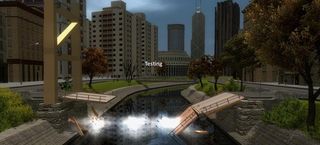
Huh. I see this simulation has cleverly included physics. Well played, video game . Forcing me to build with non-magical wood that doesn't just float in the air when I stick it there, eh? I take another crack at it, this time trying to hold up my bridge using cables. Somehow, this makes my bridge collapse even faster.

Okay! Clearly, I need more of a secure structure on top. I add some wooden beams, crisscrossing them to support the road, and then crisscrossing them again to support each other. When I run out of wood, I start using iron beams. When I run out of iron beams, I start using cables again. When I've run out of everything, I assume that means I have built the most stable and secure and awesome bridge ever. That's how professionals design bridges, right? Just take a giant pile of materials and cram them together haphazardly until there's nothing left?
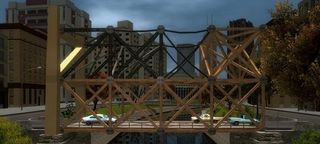
The cables lose tension, the wood crackles, the iron groans, but my bridge doesn't collapse in a big splintery pile in the water. Sure, it's ugly as hell, but it serves several functions. First, terrorist bombers looking for a tasty target will assume it's already been hit. Suicidal jumpers will take one look and decide they'd rather kill me than themselves. And, as an added bonus, cars can actually drive across it without it falling apart, as I discover when the game runs tests on the bridge by sending across some automobiles and a couple buses. My job here is done, provided my job was "Construct Needlessly Huge Shuddering Eyesore."
I move on to a new map in another city unwise enough to hire me. This time, I use iron girders and cables to construct a bridge across four lanes of traffic. Amazingly, it doesn't fall over, even as the game tests it with several buses and an earthquake. Okay, part of it falls over. I would say... a fair amount of it falls over. But most of it doesn't! Plus, as you can see below, I've cleverly placed the bridge's supports directly in the traffic lanes below, meaning I'm encouraging visitors and tourists to admire the majesty of the bridge as they fly through the windshields of their ruined cars. You're welcome, unnamed city!
Comic deals, prizes and latest news
Sign up to get the best content of the week, and great gaming deals, as picked by the editors.
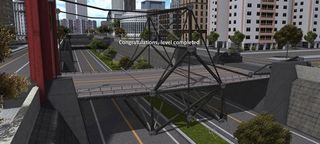
I should point this out: one of the best features of Bridge Project is that in addition to the prescribed tests for each bridge, you can also run your own manual tests. So, even if you build a simple wooden bridge on a rural map that only needs to withstand a few three-ton buses...

...you can still enjoy a pleasant wave of wanton destruction when you decide to test it for a hundred-ton train.
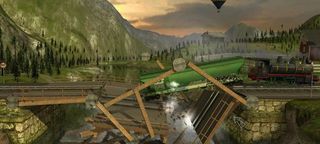
If trains aren't your thing, run a half-dozen military tanks across your bridge, or subject it to earthquakes or hurricanes. And why even wait until your bridge is complete before you start testing it? I mean, how do you even know this town needs to spend millions of dollars on a bridge unless you test the situation out first?
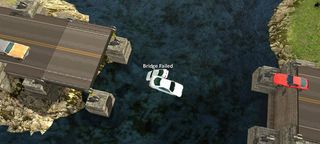
Okay, I think they might genuinely need a bridge.
Another note: even if your bridge collapses during a test, you can just go back into edit mode and it's made whole again, allowing you to tinker with and improve your design rather than build it over from scratch. This means that despite my constant failings, I never really get discouraged. Heck, failing is actually a lot of fun. In fact, why don't we dispense with the screenshots and enjoy two and a half minutes of my bridges failing on video! (Though I consider the final clip less of a failure and more of a creative success.)
Something else worth pointing out: three days after buying Bridge Project, I'm still playing it, which is unusual for this column, as you may have noticed. Also, I am actually getting better at building bridges as I play. I finally figured out how bridge pistons work: I'd been placing them under the bridge, trying to lift the entire structure up, instead of just lifting a portion so the boat can pass underneath. Also, it helps if you unlock the joints so the portion of the bridge can actually, you know, be lifted.
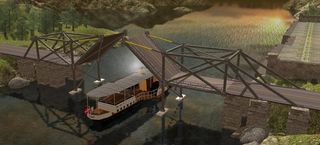
Though they'll never be tourist attractions or make an appearance on a postcard, my bridges start working, inasmuch as they don't immediately collapse when driven on. I'm getting the hang of suspension bridges, too, and I've probably unlocked about 40 of the 48 maps the game comes with. A couple of mt bridges even look sort-of-almost-kinda nice.
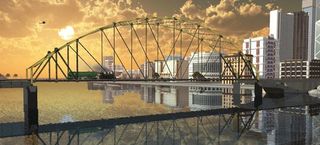
Conclusion : I am a bridge builder! A terrible one, but still, I haven't enjoyed being this terrible at a game in a long time. There's also an expert mode which I have not tried for obvious reasons, a map editor for creating your own levels, and a real-time stress analysis feature that turns the portions of your bridge bright red if they are under undue pressure, allowing you to easily spot your bridge's Achilles heel, or in my case, Achilles heel, elbow, wrist, femur, ribcage and spine:

You should be a bridge builder too. I definitely recommend you give Bridge Project a try. There's a demo that gives you a handful of maps to play with; the full version is $20. Worth it!

Chris started playing PC games in the 1980s, started writing about them in the early 2000s, and (finally) started getting paid to write about them in the late 2000s. Following a few years as a regular freelancer, PC Gamer hired him in 2014, probably so he'd stop emailing them asking for more work. Chris has a love-hate relationship with survival games and an unhealthy fascination with the inner lives of NPCs. He's also a fan of offbeat simulation games, mods, and ignoring storylines in RPGs so he can make up his own.
Most Popular


